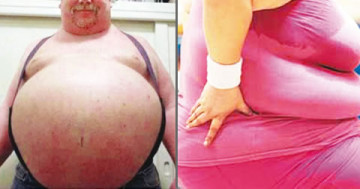Fat location determines your health risk
Source: Google photos
Fats don’t flatter the image most of the time. But beyond the aesthetic beauty that a lean body projects, researchers are now saying that the location or distribution of body fat matters when we are talking about overall wellbeing.
Scientists say that, generally, body weight is influenced by a person’s age, gene and hormonal activities on the one hand, and by the body maintenance condition — how much you exercise, diet, etc. They contend that the amount and location of fat in your body affects your risk for a number of health conditions.
Body shapes and fat distribution
According to an online beauty and fitness page, channel4.com, the apple shape is defined by an ample bust, round stomach and slimmer hips. Here, fat is mainly distributed in the abdomen, chest, and face.
The pear shape is characterised by a small bust, narrow shoulders, and bigger hips, thighs or bum. The fat is usually deposited in the buttocks, hips, and thighs. As body fat percentage increases, experts say, an increasing proportion of body fat is distributed around the waist and upper abdomen. That is why pear-shaped women tend to have a (relatively) larger derrière, thicker thighs, and small(er) breasts.
Hourglass (aka Figure 8) shape is defined by ample bust, curvy hips and a slimmer waist. Here, the body fat distribution tends to be around both the upper and lower body
The online portal, mensfitness.com, says men’s body shapes fall in two broad categories — endomorphs (stockier men) and ectomorphs (skinny ones).
Experts say while the apple shape seems to be common among men, women can be either apple or pear-shaped.
Health implications of your fat
A study led by a specialist in natural progesterone therapy, Dr. John Lee, deposes that the fat that accumulates in pear-shaped people largely lies directly under the skin (subcutaneous), while the fat of apple shapes are located in the abdomen (visceral). It is variously called organ fat or intra-abdominal fat because it is located inside the abdominal cavity and packed between the organs (stomach, liver, etc).
Another study done by researchers at Wake Forest University Baptist Medical Centre and published in the American Journal of Clinical Nutrition indicates that how much fat a person has is less important than the location when it comes to determining risk for cardiovascular disease.
Lee says visceral fat has been associated with metabolic disturbances and increased risk of heart disease, Type 2 diabetes, breast cancer and the need for gall bladder surgery.
Says Lee, “You can grasp subcutaneous fat with your hand, but visceral fat lies deep inside the abdominal cavity, where it takes up residence in the spaces between the abdominal organs. Consequently, abdominal fat is the most serious health risk.”
The North American Menopause Society says for women, especially, abdominal fat tends to increase during the menopausal years, “possibly due to declining oestrogen production and increased androgens, or male hormones.”
The non governmental organisation notes that higher levels of the stress hormone cortisol are common after menopause, while cortisol also promotes more abdominal fat.
“People who tend to deposit fat in the abdominal region are more likely to suffer from adverse health conditions than people whose fat resides in the hips and thighs,” experts say.
The trio of Doctors Lee, Jesse Hanley and Peter Eckhart in their study published on boxingscene.com, say environmental factors — such as exposure to plastics, plastic drinking bottles, commercially raised beef, chicken and pork, some personal care products, pesticides, herbicides, spermicide, detergent and canned foods — do make men to develop increased oestrogen levels, which not only make their hips fat but also pose as the main risk factor for diseases such as prostate enlargement and cancer.
The researchers say, “It is clear that increased body fat affects health, the news is that its distribution on the body influences the state of health of specific organs.”
Again, experts say, apple-shaped individuals are exposed to a greater risk of developing obesity-related diseases, as the fat is intra-abdominal and distributed around their stomach and chest.
Such people risk respiratory diseases (sleep apnea syndrome), some cancers and osteoarthritis, researchers say.
The scientists also note that pear-shaped overweight persons are at greater risk of mechanical problems, as most of their body fat is distributed around their hips, thighs and bottom.
Women fare worse where fat matters, or so researchers say. Lee contends, “Women are at a disadvantage, as their physiological processes (childbearing and hormone functions) require a plus of essential fat, the ‘sex-specific fat.’ Thus the total percentage of body fat is higher.
“Moreover, this part of essential fat is hard to dislodge. Secondly, women have less calorie-burning muscle than men, which makes it more demanding for the female to achieve a trimmer figure!”
While this is not an excuse for women to pile on the pounds, it is quite instructive.
Protect yourself
Hope is not lost, though. The Wake Forest University researchers say regardless of body shape, the risk of developing heart disease and diabetes increases with every inch added to the midsection; but with positive changes in diet and exercise habits, it’s entirely possible to reduce waist circumference.
Women are also advised to guard against the so-called mid-life spread, especially as they approach menopause.
“Beyond their clear effect on a woman’s overall health, this condition tends to compromise women’s sexual function through reduced energy, reduced mobility, poor self-image, and other factors,” experts aver.
According to the online portal, webmd.com, you can safely lose about 1.5kg a week at with a healthy diet and lots of exercise. “A diet that minimises starches, sugars and animal fat (from meat and dairy foods) will get you there.”
Physicians also recommend focusing on fruits, vegetables, egg whites, soy products, skinless poultry breasts, fish, shellfish, nonfat dairy foods, and 95 per cent lean meat.
Culled from Punch



Comments
Post a Comment